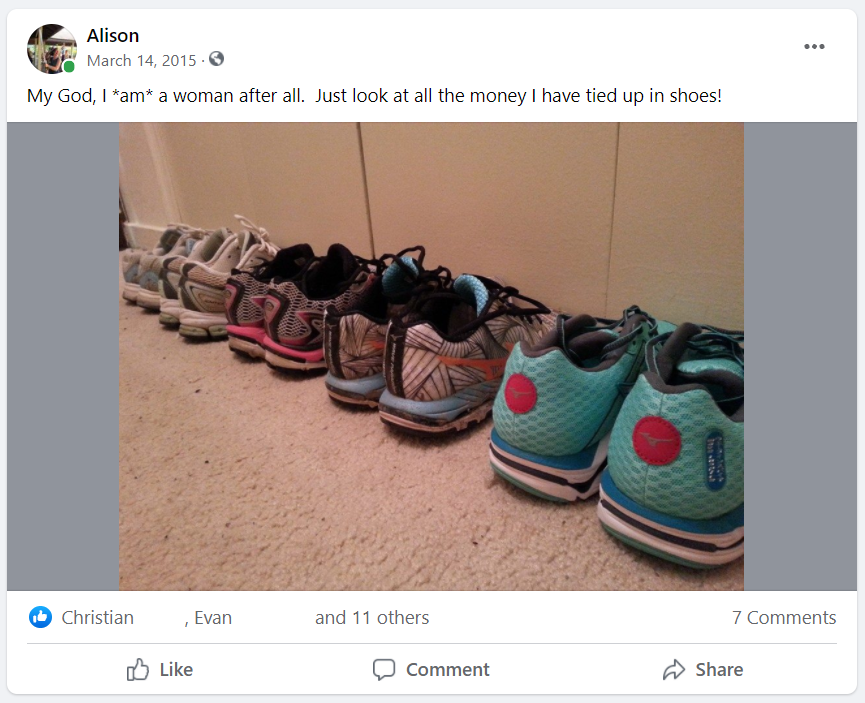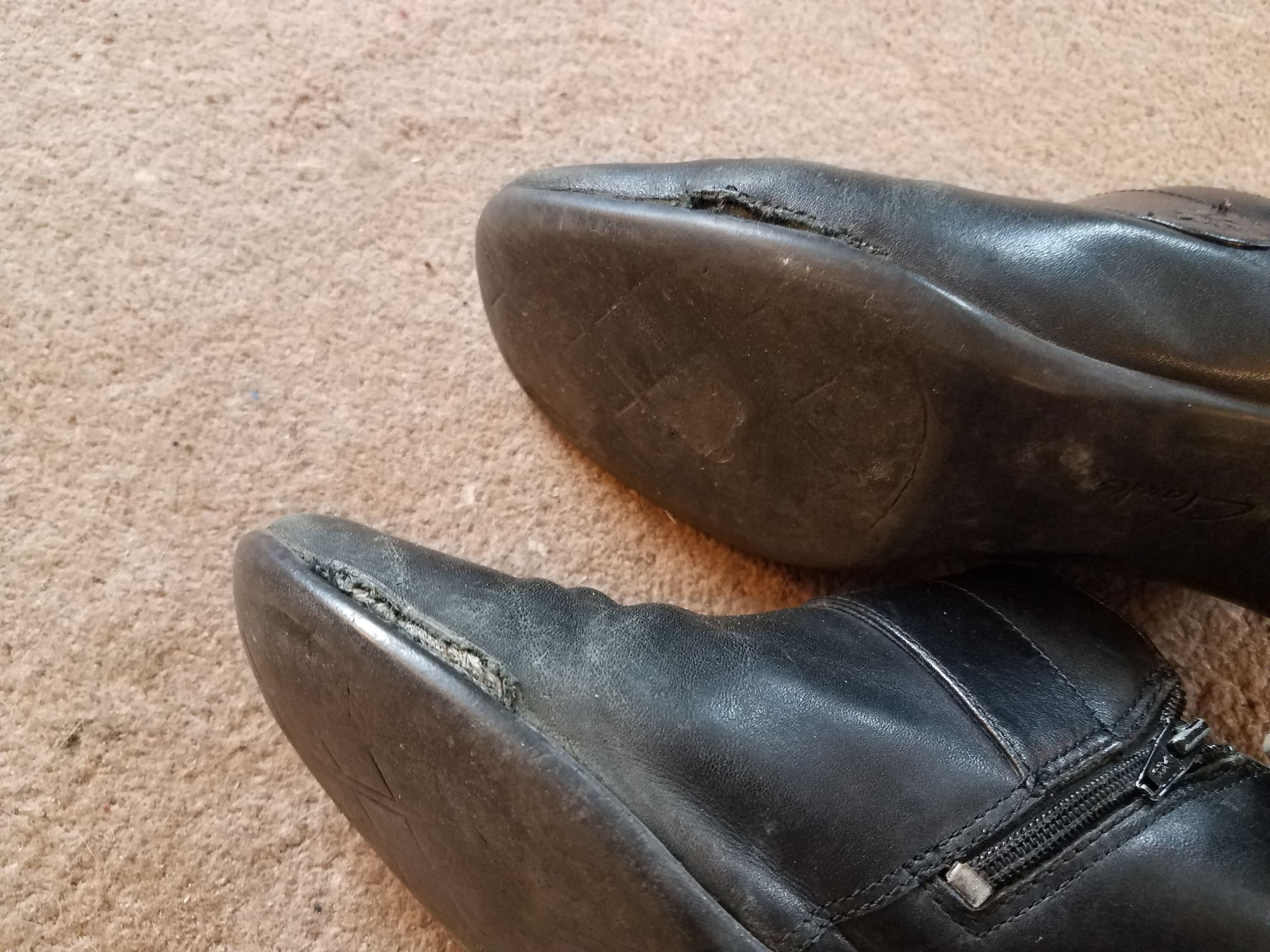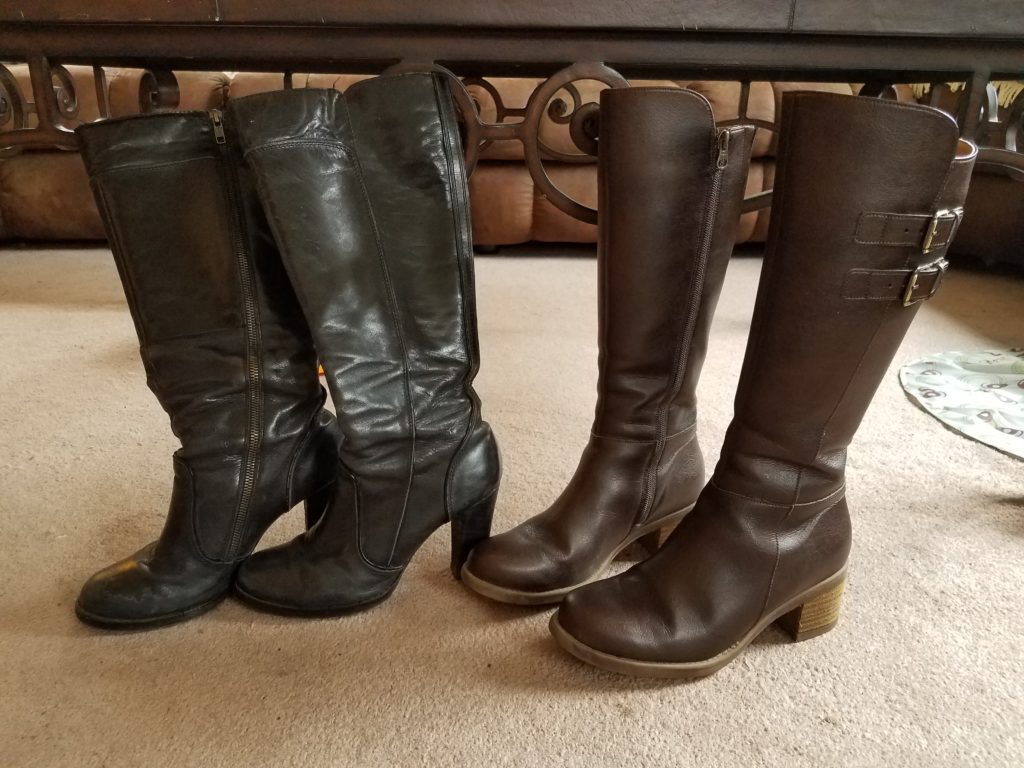Part 1 – Quality Over Quantity
It turns out that feet, footwear, and footcare are shockingly loaded topics, with several related blog posts behind me just this year alone. For someone who has never enjoyed shoes or shoe shopping, I’m surprised at the extent of my growing interest in this area – less for the fashion, and more for the human physiology and sustainability aspects of the subject.
Since I started this blog in Spring 2019, kicking it off with a “Zero Waste Lent” challenge [1] and learning just how much plastic is in what we wear, I have purchased very little clothing and (I think) no shoes. I have been incredibly mindful about the clothing I’ve added to my wardrobe since then, making sure there is as little plastic as possible, focusing instead on assembling long-lasting, quality items made from natural materials, not “fast fashion” items that will fall apart quickly and then head for the landfill.
Waste Not, Want Not
Aside from the fact that I have never liked clothes or shoe shopping, and aside from the pandemic reducing the need for new clothes, the fact is that I really don’t have the need for more clothing than what is already in my closets and drawers. One of the reasons I dislike shopping in general is analysis paralysis: I have difficulty determining the “correct,” most sustainable decision in such a complex topic. I know that synthetic materials are terrible for the environment (requiring petroleum products to produce) and quick to fall apart (breaking down into microplastics), while natural materials, while notoriously sturdy with proper care, can be hard on the environment (depending on the production process) and the animals that provide them.[2] The best answer, as always, is simply consuming less.

Environmental and ethical factors abound in this decision, so while I’ve tried to figure out the best course of action, I’ve also limited my consumption. Consequently, the last time I purchased any shoes was in December of 2018. Those shoes were, in fact, “vegan leather” (a.k.a. plastic) boots that entered my home a few months before I started this blog, almost immediately dove into research on the environmental impacts of clothing, and subsequently stopped buying almost anything new.
Fortunately, the solution of buying less in the first place was fine by me, as I truly hate shoe shopping (with the exception of running shoes). The only reason I had as many shoes as I did this past spring when I did the Marie Kondo purge [3] was because while I don’t buy much to start with, I also never throw anything away. I donated the ones I did not love (and therefore did not wear), and I’m doing my best to recycle the ones that can be recycled (mostly old running shoes).[4]
Decision Time
Unfortunately, several pairs that have been my go-to shoes over the years are finally wearing out, despite several attempts to repair them. (Note: my dad always took regular care of my leather footwear when I lived at home; I only take them to the shoemaker in case of emergencies.) Two pairs in particular have been in my regular rotation for around a decade because they look good (or did) and are (or were) supremely comfortable. They are both leather on top and have synthetic soles. The leather is in decent shape, despite the lack of regular maintenance, but the synthetic soles are breaking and separating. One pair has gone in for repairs several times, and they finally seem to be unsalvageable.
What that means is that it was past time to start looking for replacement shoes. I am a big proponent of buying second-hand as a first option because the resources have already been used to make the products, and the only additional ecological footprint associated with them comes from driving to the thrift store and back. Buying brand new items creates additional demand and generates impacts that ripple up and down the supply chain. For that reason, if I’m buying second-hand, I’ll let myself buy whatever I like, guilt-free (leather, plastic, whatever). If I’m buying new, however, I want to be incredibly mindful of where my money goes and what it supports.

Unfortunately, despite my soap-boxing, I have never once seen shoes at a second-hand store that I’ve wanted to buy. Not knocking the thrift stores in my area by any means, I think it is more a statement about the types of shoes that people tend to give away. Indeed, all of the shoes I gave up in the Kondo purge were plastic, uncomfortable, and barely holding together after very few wears. If I had shoes that were well-made, sturdy, attractive, and comfortable, I would not give them up until they were literally falling apart… which, again, is my current problem.
With my go-to shoes beyond repair and nothing appealing at the thrift store, I had to make a decision and buy something new. There are a lot of factors that went into my ultimate choice, the details of which are fodder for a slew of future posts, specifically the carbon footprint of vegan leather vs. natural leather and the ethical impact of vegan leather vs. natural leather. I will go into neither in detail in this post, but will instead focus on the value of investing in high quality products that last (which, itself, raises the issue of equity – when long-lasting items fall outside the price range of people who could most benefit from them).
The Price of Quality
While bingeing YouTube videos during a recent bout of seasonal depression, I came across a shoe company that makes historically accurate footwear from the late 1800s / early 1900s. Of course, their channel caught my attention as it was actually Edwardian dress (not medieval or Renaissance dress) that got me interested in historical costuming in the first place. The more I learned about this company, their products, and their values, the more intrigued I was.

This blog does not feature paid advertisements, but I do sometimes highlight companies or products that I find to be impressive from a sustainability standpoint, and American Duchess is one.[5] They are a small company, focused on making a quality product. They also only design and produce a few styles at a time, ordering a small variety of sizes and colors based on the quantity of pre-orders they receive. What that means is that there is little waste in the form of extra shoes that can’t be sold, but once something is gone, it’s gone.
Their website is explicit about decisions they’ve made in sourcing, production, and distribution, always keeping sustainability a priority. For example, the leather they source from Italy is a byproduct of the food industry, and the tanning process there is subject to strict regulations regarding effluent. They also wanted to ensure fair wages and treatment for their cobblers, which would make the shoes prohibitively expensive in America, so after researching the economics of manufacturing in multiple countries, they landed on Portugal. Their shipping process involves functional (not luxury) boxes and packaging made from recycled/recyclable materials.
I was impressed with their business model, the degree of consideration for sustainability across multiple facets of their work, and their transparency, brought to you with an amusing and informative narrative style on their website (not unlike what I strive for here). So I actually purchased my first pair of shoes in several years. They were significantly more expensive than what I have normally paid for professional-looking shoes in the past, but they were still less than half of what Carrie Bradshaw was paying for her Manolo Blahniks on “Sex and the City” in 2002.[6]
Despite the price tag (or, perhaps, because of it) I am looking at them as an investment that will last, hopefully, a long time with proper care. And proper care is where we will pick up next time.
~
Do you have high quality shoes that you consider an investment? Have you weighed the pros and cons of different product materials? I’d love to hear your story in the comments.
Thanks for reading!
[1] https://radicalmoderate.online/zero-waste-lent-week-5-clothing/
[2] https://radicalmoderate.online/plastic-free-july-corona-edition-part-4/
[3] https://radicalmoderate.online/tidying-up-week-2/
[4] https://trashisfortossers.com/how-to-recycle-old-clothing
[5] https://www.americanduchess.com/
[6] https://www.youtube.com/watch?v=v2PpWmwKihE
0 Comments